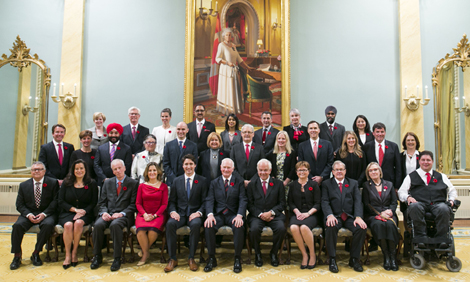


Canadian Prime Minister Justin Trudeau (front row, fifth from left) posed for a group photo with his new cabinet during the swearing-in ceremony at Rideau Hall in Ottawa, Canada, on November 4, 2015.
On October 19, 2015, Justin Trudeau became Canada’s new prime minister, or head of government. At 43 years old, he is the second-youngest prime minister in Canadian history. In this election, Canadians also elected their most diverse Parliament ever.
In Canada, the people don’t vote directly for their prime minister. The recent election was to vote for Members of Parliament (MPs) to the House of Commons. Along with the Senate and the Sovereign, the House of Commons is one of the three main parts of the Canadian Parliament. The political party that wins the most seats in the House of Commons becomes the majority party, and the leader of that party becomes prime minister.
In the latest election, the Liberal Party of Canada, led by Trudeau, won 184 seats, which was enough to become the new majority party. Trudeau was then named the new prime minister. Before this election, the Conservative Party of Canada held the majority for nine years. Trudeau said that his party won such a big victory because of its positive vision for Canada. The Canadian people also elected more women, First Nations people, and Muslims than before, making the Parliament more diverse than ever. The First Nations are the more than 600 groups of native peoples who live in Canada.
Trudeau appointed a diverse cabinet, or team of advisers, to help him govern Canada. His 30-member cabinet is the first in his country’s history to have equal numbers of men and women. Adding to the team’s diversity are two First Nations members, two people with physical challenges, and four Sikhs. Sikhs are people who follow the South Asian religion of Sikhism.
The new Minister of National Defense, Harjit Sajjan, was the first Sikh Canadian to command a Canadian army regiment. Sajjan immigrated to Canada from India when he was five years old. Maryam Monsef, the new Minister of Democratic Institutions, is the first Muslim to be named to a Canadian prime minister’s cabinet. Also among the 15 women appointed to the cabinet is Kirsty Duncan, a medical geographer and associate professor of health studies now serving as Minister of Science.
In naming Canada’s new ministers, Trudeau said he wanted “a cabinet that looks like Canada.” In other words, he wanted his team of advisers to represent the Canadian people’s many different cultures and backgrounds.


























